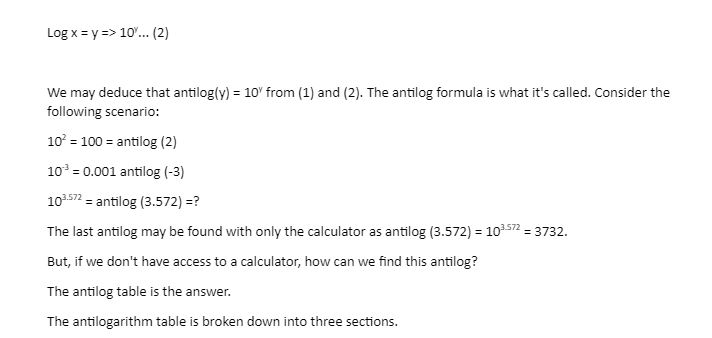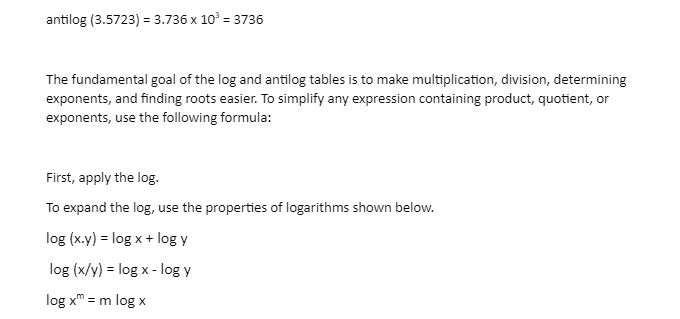Introduction:
In mathematics, The logarithm is an inverse function of exponentiation. That is, the logarithm of a number x is the exponent to which another given fixed number, the base b, must be raised in order to obtain that number x. The logarithm counts the number of times, the same factor appears in repeated multiplication in the simplest case;
for example, since 1000 is equal to 10*10*10 = 103,
The logarithm base is 10 of 1000 is 3, or log10 (1000) = 3. When no mistake is conceivable, or when the base does not important, such as in big O notation, the logarithm of x to base b is denoted as logb (x), or without parenthesis, logb x, or even without the explicit base, log x. The decimal logarithm is a logarithm with base 10 (that is, b = 10) that is highly used in science and engineering. Because of its easier integral and derivative, the natural logarithm has the number e (that is, b 2.718) as its base. It is widely used in mathematics and science. Binary logarithm has base 2 (b = 2), is widely used in computer science.
The function f(x) = bx is known as an antilogarithm since it is the inverse of logbx. This function is now more generally referred to as an exponential function.
ANTILOG TABLE
The antilog table is used to calculate a number’s anti-logarithm. The inverse of log is the antilog function of the given function. We all know that the log table is useful for quickly performing math computations without the assistance of a calculator. When performing computations, we should first apply the log to the supplied expression, then use the antilog table to get the antilog of the result, which yields the simplified result of the given expression.
Let’s take a closer look at the antilog table, including how it works and how to utilize it with positive and negative integers. For a better knowledge of how to use the antilog table, we’ll solve some instances.
What is an Antilog Table, and how does it work?
The antilog of a positive or negative number is found in the antilog table. The inverse of a logarithmic function is antilog. If log x Equals y, then x must be antilog (y). If “log” is moved from one side of the equation to the other, it becomes an antilog. So
Log x = y => x= antilog(y)…(1)
However, we can convert a logarithmic equation to an exponential equation using the log formula. As a result,

The first column (primary column) has numbers ranging from.00 to.99.
The digits 0 to 9 are displayed in the second block (differences columns).
The digits 1 to 9 are displayed in the third block (mean differences columns).
Antilog Table – How Do I Use It?
When calculating the logarithm of a number, antilog is always used. We know that the logarithm of any number is defined as characteristic + mantissa, with the characters being either positive or negative and the mantissa always being positive. Let’s review how to remove the characteristic and mantissa from a number’s logarithm. In the case of negative numbers, be cautious when looking for them (in the case of negative numbers we add and subtract 1 to make mantissa positive).
How to Use an Antilog Table to Find the Antilog of a Number
Here’s how to use the antilog table to find the antilog of a number. Let’s pretend we’re looking for antilog (3.5723).
Step 1: Locate the mantissa and its characteristics.
Mantissa = 0.5723 and characteristic = 3.
Phase 2: In this step, focus solely on the mantissa. Find the equivalent number from the log table using the first two digits after the decimal point as the row number and the third digit as the column number.
The number 3733 is found in row 0.57 and column 2.
3rd step: Look for the mean difference corresponding to the 4th digit of the mantissa in the same row. This should be added to the value from Step 2.
The mantissa’s fourth digit is 3 in this case, and the associated mean difference is 3.
3733 + 3 = 3736
Step 4: Always include a decimal point after the first digit (of the number from Step 3).
After that, it becomes 3.736.
Step 5: Multiply the result of Step 4 by 10characteristic, which is the antilog of the provided number.

To find the logarithm of any number and simplify the equation to a single number, use the log table.
Using the antilog table, find the antilog of the number from the previous step, and that will be the final result of the supplied expression.
Points to remember:
- the antilog of any positive or negative number is always positive.
- When determining the antilog of a number, we use its mantissa to determine the appropriate number from the log table, and we use its characteristic to determine where the decimal point should be placed.
- When performing any calculation involving logarithms, we must always apply antilog after simplifying the expression’s log.
- If log y = x, then y = antilog x is the result.
- The basis of both the logarithm and the antilog is 2.7183. If the base of the logarithm and antilogarithm is 10, multiply them by 2.303 to get the natural logarithm and antilogarithm.
 Profile
Profile Settings
Settings Refer your friends
Refer your friends Sign out
Sign out






